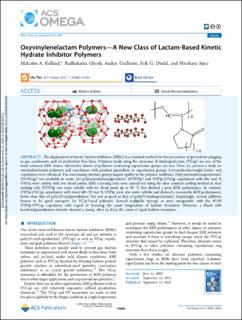| dc.contributor.author | Kelland, Malcolm Andrew | |
| dc.contributor.author | Ghosh, Radhakanta | |
| dc.contributor.author | Undheim, Audun | |
| dc.contributor.author | Dirdal, Erik Gisle | |
| dc.contributor.author | Ajiro, Hiroharu | |
| dc.date.accessioned | 2023-02-17T12:47:36Z | |
| dc.date.available | 2023-02-17T12:47:36Z | |
| dc.date.created | 2022-11-18T14:40:09Z | |
| dc.date.issued | 2022 | |
| dc.identifier.citation | Kelland, M. A., Ghosh, R., Undheim, A., Dirdal, E. G., & Ajiro, H. (2022). Oxyvinylenelactam Polymers─ A New Class of Lactam-Based Kinetic Hydrate Inhibitor Polymers. ACS omega, 7(40), 35686-35693. | en_US |
| dc.identifier.issn | 2470-1343 | |
| dc.identifier.uri | https://hdl.handle.net/11250/3051972 | |
| dc.description.abstract | The deployment of kinetic hydrate inhibitors (KHIs) is a chemical method for the prevention of gas hydrate plugging in gas, condensate, and oil production flow lines. Polymers made using the monomer N-vinylcaprolactam (VCap) are one of the most common KHI classes. Alternative classes of polymers containing caprolactam groups are rare. Here, we present a study on oxyvinylenelactam polymers and copolymers with pendant piperidone or caprolactam groups. Low-molecular-weight homo- and copolymers were obtained. The nonrotating vinylene groups impart rigidity to the polymer backbone. Poly(oxyvinylenecaprolactam) (POVCap) was insoluble in water, but poly(oxyvinylenepiperidone) (POVPip) and OVPip:OVCap copolymers with 60+ mol % OVPip were soluble with low cloud points. KHI screening tests were carried out using the slow constant cooling method in steel rocking cells. POVPip was water soluble with no cloud point up to 95 °C but showed a poor KHI performance. In contrast, OVPip:OVCap copolymers with about 60–70 mol % OVPip were also water soluble and showed a reasonable KHI performance, better than that of poly(N-vinylpyrrolidone) but not as good as that of poly(N-vinylcaprolactam). Surprisingly, several additives known to be good synergists for VCap-based polymers showed negligible synergy or were antagonistic with the 62:38 OVPip:OVCap copolymer with regard to lowering the onset temperature of hydrate formation. However, a blend with hexabutylguanidinium chloride showed a strong effect to delay the onset of rapid hydrate formation. | en_US |
| dc.language.iso | eng | en_US |
| dc.publisher | American Chemical Society | en_US |
| dc.rights | Navngivelse 4.0 Internasjonal | * |
| dc.rights.uri | http://creativecommons.org/licenses/by/4.0/deed.no | * |
| dc.title | Oxyvinylenelactam Polymers-A New Class of Lactam-Based Kinetic Hydrate Inhibitor Polymers | en_US |
| dc.title.alternative | Oxyvinylenelactam Polymers-A New Class of Lactam-Based Kinetic Hydrate Inhibitor Polymers | en_US |
| dc.type | Peer reviewed | en_US |
| dc.type | Journal article | en_US |
| dc.description.version | publishedVersion | en_US |
| dc.rights.holder | The authors | en_US |
| dc.subject.nsi | VDP::Matematikk og Naturvitenskap: 400 | en_US |
| dc.source.pagenumber | 35686-35693 | en_US |
| dc.source.volume | 7 | en_US |
| dc.source.journal | ACS Omega | en_US |
| dc.source.issue | 40 | en_US |
| dc.identifier.doi | 10.1021/acsomega.2c03644 | |
| dc.identifier.cristin | 2076501 | |
| cristin.ispublished | true | |
| cristin.fulltext | original | |
| cristin.qualitycode | 1 | |

